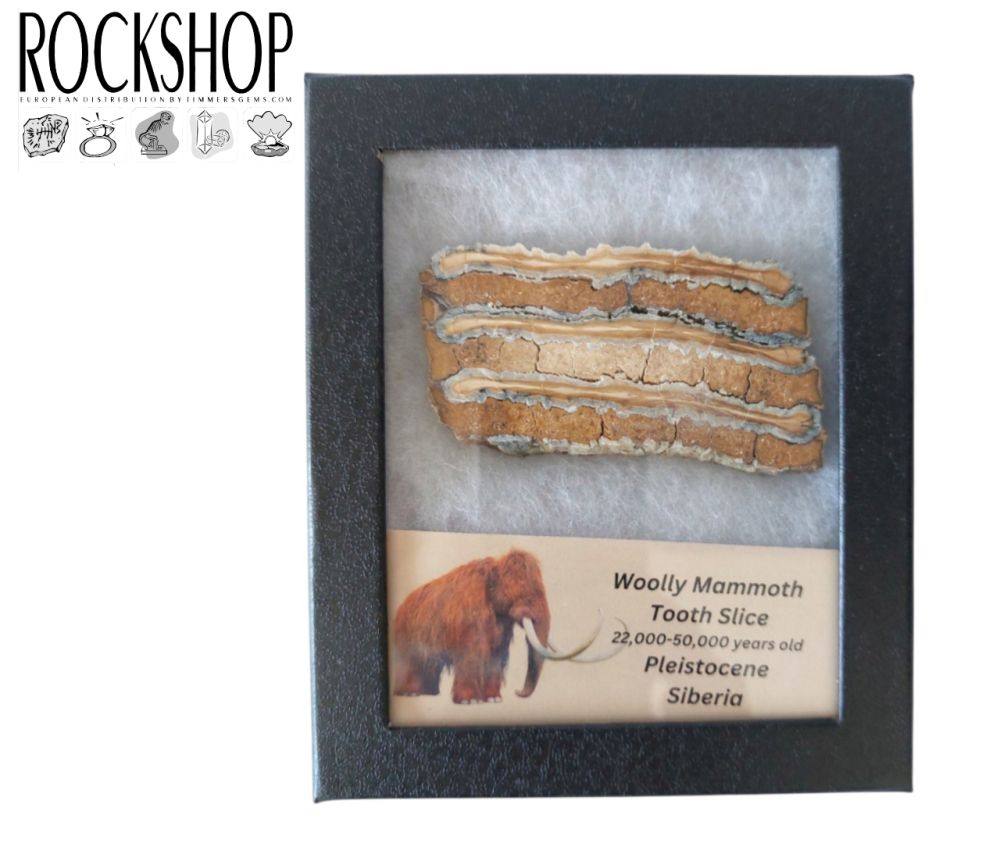We use cookies to make your experience better.
TimmersGems has a new website, existing customers also need to register again.
Slices of mammoth tooth packaged in a luxury case with description. Originating from Siberia.
In the mineralium we have very special fossils, such as megalodon teeth, ammoliths, life-size orthoceras, mammoth fragments, etc.
Availability:
In stock
SKU
122196
Fossils are all remains and traces of plants and animals that are preserved in rock. Contrary to popular belief, fossils do not necessarily require 'petrification'. Very many fossils are indeed not petrified. Even from very old rocks, fossil remains are known that have hardly changed. Furthermore, many people think that fossils are always very old. This is also incorrect. There are many very young fossils known, formed in periods known to humans. The science that studies fossils is called palaeontology. This field of knowledge helps in the research into the succession of rocks, a branch within geology called biostratigraphy. Because remains of life only fossilise under specific circumstances, fossil information is limited and, by definition, "incomplete". When people hear the word fossil, they often think of the bones of dinosaurs or mammoths, and it is indeed true that the hard parts of an organism have the greatest chance of being preserved by fossilisation. For vertebrates, these are the bones and especially the teeth. The softer tissues of the organism are only preserved in special cases and are therefore much rarer. Softer tissues are only preserved if they are quickly buried under a layer that protects them from any form of rotting or gnawing. With only the hard parts, it is sometimes difficult to form a good picture of the complete organism. A good example of this are the Conodonta, which were found in large numbers for a long time but were only known from their teeth. Only when an impression of the rest of such an animal was found did it become apparent that this was a primitive form of the phylum Chordata. In other animal groups, other hard parts, such as shells, are often fossilised. There are a number of special forms of fossilisation. For example, complete insects are sometimes enclosed in amber because the resin from which the amber is formed forms a good seal against oxidation. This also applies on a larger scale to tar pits. Near the American city of Los Angeles is a good example of this in the La Brea Tar Pits. The bones of animals that were trapped in the tar pit were often exceptionally well preserved. In addition, the trapped animals often attracted predators, which also became entangled. In this way, a "bone graveyard" was formed during the Pleistocene. In clays that were deposited in stagnant, anoxic water, very well-preserved fossils are often found. Due to the absence of oxygen, plants fossilise particularly well in them. Very often, not the entire water column is anoxic, but only the lower part. Such stratified water therefore has a normal oxygen content in the upper layer. Organisms die in the upper layer and then sink down and end up in an anoxic environment where they are preserved. Living organisms can also unintentionally end up in the lower anoxic layer, causing them to die and fossilise. In such a deposit, fish are sometimes preserved in a cramped manner, which indicates suffocation. A well-known rock with such fossils is the 'Kupferschiefer' from Rotliegend in Central Germany. In addition to remains that originate from organisms themselves, traces that have been actively or passively made by organisms are also considered fossils. These include, for example, coprolites (fossilised faeces) and trace fossils such as footprints and burrows. It is not always possible to determine which animal trace fossils come from. Therefore, they often receive their own taxonomic name.
| Dimensions | Divers |
|---|---|
| Country of Manufacture | United States |












